2024 STEM Educators’ Lecture Recap
By Cliff Rouder, Ph.D.

The CAT’s STEM Educators’ Lecture, held on April 10, 2024, featured guest speakers Dr. Tara Nkrumah and Cornelio “Coky” Aguilera. Dr. Nkrumah is an Assistant Professor in the Department of Teacher Preparation, Mary Lou Fulton Teachers College at Arizona State University. Her research is on equitable teaching practices for anti-oppressive discourse in education and science, technology, engineering, and mathematics (STEM). Coky Aguilera studied as an Acting Specialist at UW Madison, works professionally with Tampa-area theater companies, and along with Dr. Nkrumah and colleagues have brought the Theatre of the Oppressed to different universities to engage academic audiences in critical investigations of inequities. Check out this Youtube video to learn more about the historical roots of Theatre of the Oppressed.
We were delighted to have their colleagues Dr. Vonzell Agosto, Dr. Deirdre Cobb-Roberts, and doctoral candidate Maria Migueliz Valcarlos join as they engaged Temple STEM and theater faculty in an interactive and engaging session titled, Unmasking the “Isms” in STEM Education to Promote Equitable Teaching and Learning. The speakers began by introducing a framework for the session–Iris Marion Young’s Five Faces of Oppression. They used this framework to help us think about how “isms” such as racism, ableism or genderism can manifest through the five faces of oppression, which are
- Exploitation
- Marginalization
- Powerlessness
- Cultural Imperialism
- Violence
- For a more in-depth look at this framework, see Young’s “Five Faces of Oppression” in Geographic Thought: A Praxis Perspective.
As participants worked through definitions of these facets of oppression and shared examples of how they can manifest in our disciplines, departments, and classrooms, the speakers then engaged participants in a series of theater-based exercises that encouraged them to use mimicry and the creation of human tableaus to explore and address physical and emotional aspects of oppression.
For more on Dr. Nkrumah’s research, check out these recent publications:
- Nkrumah, T. (2023). The Inequities Embedded in Measures of Engagement in Science Education for African American Learners from a Culturally Relevant Science Pedagogy Lens. Education Sciences, 13(7), 739.
- Nkrumah, T., & Scott, K. A. (2022). Mentoring in STEM higher education: a synthesis of the literature to (re) present the excluded women of color. International Journal of STEM Education, 9(1), 1-23.
- Nkrumah, T., & Mutegi, J. (2022). Exploring racial equity in the science education journal review process. Science Education, 1-15. https://doi.org/10.1002/sce.21719
As always, our CAT staff is ready to help you! To explore how to incorporate this work into your STEM courses or how to design and implement classroom-based research in this area, book a consultation appointment or email a CAT staff member directly.
Faculty Adventures in the AI Learning Frontier: Assignments and Activities that Address Ethical Considerations of Generative AI Use
by Benjamin Brock, Ph.D and Dana Dawson, Ph.D

In response to our fall 2023 survey on the use of generative AI (GenAI) in the classroom, we received a number of assignments and activities faculty members have designed to tackle the ethical issues raised by GenAI. Ethical concerns related to GenAI include such considerations as the implications for privacy when these tools are used, the possibility of over-reliance on GenAI for analytics and decision making, and exposure to inaccurate or biased information (Brown & Klein, 2020; Masters, 2023; Memarian & Doleck, 2023). The following activities and assignments equip students with the capacity to critically evaluate when and how it is appropriate to use GenAI tools and to protect themselves against possible risks of AI use.
Sherri Hope Culver, Media Studies and Production faculty member and Director of the Center for Media and Information Literacy (CMIL) at Temple University, asks students in her GenEd course, Media in a Hyper-Mediated World, to complete a reflection on the implications of AI use. She first asks them to listen to an episode of the podcast Hard Fork centered on data privacy and image manipulation and to read the Wired article “The Call to Halt ‘Dangerous’ AI Research Ignores a Simple Truth” (Luccione, 2023). Students are then instructed to write a 300-word reflection referencing the assigned material that addresses both concerns they have about use of AI and ways in which it could make their lives or society better. Professor Culver provides the following prompts to help students’ thinking:
- What does critical thinking mean in a tech-centric, AI world?
- How might AI affect your free will?
- How might AI affect your concerns about privacy or surveillance?
- How should we prepare ourselves for an increasingly AI world?
- How might AI influence the notion of a public good?
- How might AI influence K-12 education?
- How might AI influence family life?
- What worries you about AI?
- What excites you about AI?
- What is our responsibility as media creators when we use AI?
- It has been said that AI will make life more “fast, free and frictionless.” Should everything first be “fast, free and frictionless”? Should that be the aim?
- Is AI the end of truth?
In a dynamic, interactive, reflection-oriented honors course aimed at exploring the four pillars of Temple’s Honors Program (inclusive community, intellectual curiosity, integrity in leadership, and social courage), Dr. Amanda Neuber, Director of the Honors Program, is using AI as the discussion anchor for their unit on “integrity in leadership.” By way of multiple media modalities, students delve into the ethical and unethical uses of AI in academia. Students are asked to read “How to Use ChatGPT and Still Be a Good Person” and watch a related video exploring the meaning of integrity. Students then discuss whether or not AI can be used with integrity, how academic culture might frame one’s decision to use AI, and the “peaks and pitfalls” of AI use. Beyond the many important conversations focused on AI itself, the technology is used as a reference point as to what it means to lead with integrity and how to promote said quality in teams and organizations.
In another interactive, thought-based classroom initiative, mechanical engineer Dr. Philip Dames is bringing ethics and AI to Temple’s College of Engineering. Having reimagined for a modern era the “trolley problem” philosophical exercise in which one is faced with an ethical dilemma, students in Dr. Dames’ class consider having AI make decisions using autonomous cars as the basis for deliberation. They are prompted to think about how a vehicle should be programmed to respond to different scenarios by using examples from MIT Media Lab’s Moral Machine website. Students then reflect upon their scenario-based activities and experiences and engage in prompt-guided written reflection. Prompts include questions such as:
- How does the ownership model of autonomous vehicles affect how they should behave? For example, does it make a difference if a vehicle is owned by a single private citizen vs. publicly owned by the city and hired by individuals?
- What surprised you about the aggregated responses from different people shown to you at the end of the exercise?
- Are there other factors that you feel are important but were not considered in Moral Machine?
In this way, students not only explore elements to consider when designing autonomous vehicles, but make concrete what was once only abstract via critical thinking and hands-on engagement.
If you’d like more guidance on exploring how to use AI tools in your class, please visit our Faculty Guide to A.I. and/or book an appointment for a one-on-one consultation.
Brown, M., & Klein, C. (2020). Whose data? Which rights? Whose power? A policy discourse analysis of student privacy policy documents. The Journal of Higher Education, 91(7), 1149–1178. https://doi.org/10.1080/00221546.2020.1770045
Masters, K. (2023). Ethical use of artificial intelligence in health professions education: AMEE Guide No. 158. Medical Teacher, 45(6), 574–584. https://doi.org/10.1080/0142159X.2023.2186203
Memarian, B., & Doleck, T. (2023). Fairness, accountability, transparency, and ethics (FATE) in artificial intelligence (AI) and higher education: A systematic review. Computers and Education: Artificial Intelligence, 5 (2023), 1-12. https://doi.org/10.1016/j.caeai.2023.100152
Faculty Adventures in the AI Learning Frontier: Teaching with Generative AI in Health Sciences Education
by Jonah Chambers, MA and Cliff Rouder, EdD

As part of our fall 2023 survey on generative AI (GenAI) in the classroom, we heard back from a wide variety of Temple faculty who teach a broad range of courses. In this installment, we’re going to take a look at how three health science instructors are incorporating GenAI tools like ChatGPT into their teaching.
Scott Burns, Professor of Instruction in the Department of Health and Rehabilitation Sciences, had his graduate physical therapy students prompt ChatGPT to create a generic plan of care for a specific health condition and then provide a detailed explanation of how the exercises it prescribes may or may not properly address the condition described in the scenario under consideration. In addition to having students demonstrate their knowledge of what constitutes a good plan of care by evaluating and critiquing the AI-generated plan, Professor Burns explains that the goal of the activity is to highlight that while generative AI may be useful for broad recommendations, it “currently lacks the ability to provide decision-making and rationale backed by anatomy, neuroscience, motor control/learning, and physiology.”
Before he launched the assignment, Dr. Burns surveyed his class about their experiences with and perceptions of GenAI. He also wanted to gauge the level of anxiety surrounding it, given that there is concern in health-related fields that AI could replace the human provider. Students reported that they appreciated the opportunity to interact with AI, since the experience level with AI varied, and some had never even used it before. Dr. Burns plans to administer a more formal survey for the end of the semester to see if student perceptions of AI have shifted.
Alissa Smethers, Assistant Professor in the Department of Social and Behavioral Sciences, had her nutrition students prompt ChatGPT to create a 1-day, 2,000 kcal dietary pattern for a popular diet of their choice (Keto, Paleo, Atkins, etc.) and then submit the outputs to an established dietary analysis program and answer the following questions:
- Does the plan provide 2000 kcal? If not, how far off was it?
- Does the macronutrient composition and food choices reflect the popular diet you chose? If not, what foods would you add/remove?
Her students were surprised at how far off ChatGPT was at times, in some cases generating plans that differed by over 800 kcal from what the dietary analysis program provided. The goal was not only to ensure that students are learning the correct information but also that they develop critical thinking and research skills crucial to their work as nutrition professionals. In the future, she is considering having students evaluate how well ChatGPT is able to tailor the dietary patterns based on culture, income level, or other more personalized factors as well as reflect on the limitations of using a generative AI tool to create dietary patterns vs. working with a nutrition professional like a Registered Dietitian.
Leah Schumacher, Assistant Professor in the Department of Social and Behavioral Sciences, invited Health Science and Human Behavior students to roleplay as someone who either wants to avoid or already has a chronic disease and has turned to ChatGPT to provide answers or advice. She first asked students to pick one of the diseases they covered in her class and then pose questions about it to ChatGPT such as “Why did I have a stroke?” or “How do I avoid getting cancer?” She then had students prepare a submission for the assignment that included:
- The full prompt they submitted to ChatGPT
- The full response ChatGPT provided
- A short 5-7-sentence reflection that compared the ChatGPT response to what they had learned in class through textbook readings, lectures, videos, etc. Specifically, she asked students to reflect upon the extent to which ChatGPT’s response hit upon aspects of the biopsychosocial model they studied in class, whether it touched upon major risk factors they covered, and if ChatGPT presented any information that was new to them.
Dr. Schumacher was careful to have students clearly distinguish between text generated by ChatGPT and their own written work in their submission. Not only did this assignment have students apply their understanding of the biopsychosocial model to a diverse set of cases, it also gave them the opportunity to reflect upon (and illuminate problematic aspects of) how people may use ChatGPT in their everyday lives.
Each of these professors has illuminated one of the most powerful ways of using GenAI in teaching: instead of taking its outputs at face value, they have their students question, evaluate, analyze and verify them using a variety of methods. Not only does this provide students an opportunity to apply their knowledge (a proven way to promote deep learning), but it also helps them sharpen their critical thinking skills surrounding the use of GenAI. These skills will likely not only prove helpful to them now but also in their future professional lives.
In the next installment, we’ll be looking at ethics in AI. In the meantime, if you’d like more guidance on exploring how to use AI tools in your class or assistance running your assignments through GenAI to better assess the value of using it, please visit our Faculty Guide to A.I., attend a workshop on using generative AI for teaching and learning, or book an appointment for a one-on-one consultation.
Faculty Adventures in the AI Learning Frontier: AI and (First Year) Writing
by Jeff Rients

As part of our fall 2023 survey on AI in the classroom, we heard back from a wide variety of Temple faculty who teach a broad range of courses. In this installment, we’re going to take a look at what three First Year Writing instructors are doing with AI tools like ChatGPT.
First year writing instructor Jacob Ginsburg incorporated “AI and education” as a theme in his course. His students read Ted Chiang’s “Chat GPT is a Blurry JPEG of the Web,” Matteo Wong’s “AI Doomerism is a Decoy,” and some academic articles about the role of AI in education. In class, each student writes a paragraph about what it means to them to be a member of their generation. As homework, they then give ChatGPT four tasks:
Respond to the same prompt as they wrote about in class (i.e. what it means to be a member of their generation).
Make an argument FOR the use of AI in education.
Make an argument AGAINST the use of AI in education.
Each student devises a “silly” or “fun” task of their own.
Afterwards, everyone then discusses their prompts and results in class.
Professor Amy Friedman challenges her students to write an essay in which they summarize several disparate, current articles on generative AI in education and learning. She has used articles such as Valerie Pisano’s “Label AI-Generated Content,” Allison R. Chen’s “Research training in an AI world,” and Naomi S. Baron’s, “How ChatGPT Robs Students of Motivation to Write and Think for Themselves.” Her goal is for each student to formulate and articulate their own opinion about the role of generative AI in their own learning and education. Beforehand, students explore ChatGPT in class, including asking it to write in response to previous essay prompts. The class then collectively assesses the results and compares them to their own writing.
Meanwhile at Temple’s Japan campus, Ryan Rashotte has developed two activities for his first year writing students. In the first one, students writing essays about a film ask ChatGPT to write a paragraph regarding how a specified element in the film supports a theme they are exploring. In response, students write about the strengths and weaknesses of ChatGPT’s argument. In the second assignment, students working in groups explore which art form they think is superior – television or film. As part of this investigation, they query ChatGPT for reasons in support of their choice. Students identify new and/or interesting arguments and identify their strengths and weaknesses. They are asked to consider how well the ChatGPT output would work if it were incorporated into their essay.
In the next installment, we’ll be looking at the way AI tools are being used in a variety of health sciences learning environments. In the meantime, if you’d like more guidance on exploring how to use AI tools in your class, please visit our Faculty Guide to A.I. and/or book an appointment for a one-on-one consultation.
Faculty Adventures in the AI Learning Frontier: Introduction
by Dana Dawson, Ph. D

Associate Director’s log, stardate 4616.2. Temple University. While minding our own business over here, someone invented generative AI and made it readily accessible to the people of Earth, which includes our students. We find ourselves in a strange and unfamiliar landscape; computer probability projections are useless due to insufficient data¹. Some faculty members have boldly entered this new terrain.
_______
We decided to call this blog series Faculty Adventures in the AI Learning Frontier not only because Google’s new AI tool Gemini suggested the title but because of its resonance with Star Trek. The original television series and its many reboots and spin-offs depict intrepid adventurers exploring the deep reaches of space, the “final frontier,” as we were reminded at the beginning of each episode. With the rapid evolution of generative AI, we find ourselves standing on the threshold of a strange new world. Teaching in the age of AI is, indeed, a new frontier; instructors are boldly going where no instructor has gone before. With great ingenuity, and at times trepidation, faculty members throughout Temple have begun to explore what it means to integrate AI into their class planning and delivery.
Over the course of this series, we will showcase examples of activities and assessments that Temple faculty members used in their classes in Fall 2023. In our March 11th post, we will feature assignments used in First Year Writing courses. March 25th will focus on implementation of generative AI assignments and activities in the health sciences and our final post on April 15th will include examples of how instructors across different disciplines have addressed ethics in the use of generative AI. Some of the featured activities and assessments have been designed to help students practice implementing generative AI in their fields while others encourage students to critically interrogate the impact of AI.
Whether we like it or not, generative AI is now part of our–and our students’–world. It is our responsibility not just to familiarize ourselves with these tools but to help our students make decisions about their use and, should they choose to use them, to do so effectively and ethically. We hope this series will give you some concrete and applicable examples of how to address generative AI in your courses.
_______
¹ The Gamesters Of Triskelion, Original Airdate: 5 Jan, 1968.
Being Proactive About Student Success: Six Easy Interventions to Support Students in Week Five
Dana Dawson, PhD and Linda Hasunuma, PhD
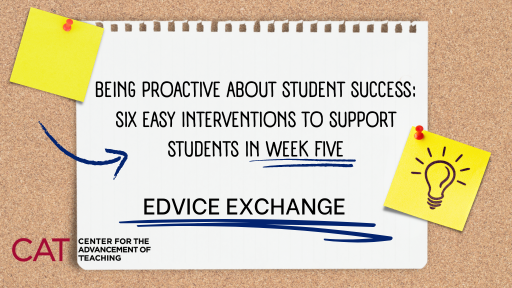
It’s common for faculty members to use midterm exams or projects to assess student progress, however, for students who are struggling, a midterm check-in may come too late to effectively address challenges. In this post, we’ll talk about ways to check in with students earlier in the semester and what to do if students are missing classes and assignments or their work demonstrates a need for additional support.
Enter your Midterm Progress Ratings for Academic Progress
In spring 2024, Midterm Progress Ratings (MPRs) for undergraduate classes will be open from January 31, 2024 to March 11, 2024. This is three weeks earlier than in previous years so that instructors can provide targeted outreach to students who may need additional guidance or resources to support their learning and retention. It’s a good idea to check your rosters for students who have missed classes or assignments, or whose submitted work is not meeting a passing standard and enter progress ratings as early as possible. It won’t come as a surprise to faculty that missed classes and assignments in the first weeks of classes are a strong predictor of poor course outcomes, so the sooner these patterns are identified, the better.
Some advising units use MPRs to identify students who require additional outreach and support. Students are also notified if a professor has submitted an MPR. While this can be a helpful indicator to some students that they are at risk of not succeeding in the course, for others, a rating of “Unsatisfactory” can be discouraging, so we recommend reaching out to students who are identified as “Unsatisfactory” (more on that below). There is a helpful guide to completing MPRs available in TU Portal.
Reach Out to Students Whose Attendance, Course Engagement and/or Work on Assignments is Cause for Concern
If in the process of reviewing student performance and completing MPRs, you notice a student has not been regularly engaging with your course or is struggling with assignments, check in with the student. You might send an email using TUmail or the Canvas email function or have a brief chat with the student after class. You can also check the “People” function in Canvas to see how much time students have spent in the course and email them directly from there. Some faculty members schedule meetings with students around the quarter-semester mark, though the size or number of your classes may prohibit this option. If you have too many students to make bespoke outreach possible, Canvas’s “message students who” function can help.
Be sure to communicate to the student that you want them to succeed and that you’re there to help. Share information on resources such as the Student Success Center, Disability Resources Services, Cherry Pantry, and the Wellness Resource Center. If you want to learn more about available resources, the Dean of Students office has a “Red Folder” with advice on making appropriate referrals.Temple has also made new apps available to students who may need mental health counseling, such as TogetherAll and Welltrack Boost. Checking in with your students demonstrates your care and concern, which can also make a difference to a student who may be feeling overwhelmed or struggling.
Give a Word of Encouragement
This is the time in the semester when the full weight of their obligations begins to hit students. Assignment due dates start to amass. Midterm exams loom. A majority of Temple students hold at least one part-time job and many participate in extracurricular activities, some of which are required by their colleges. It’s a good time to remind our students that we see and appreciate their work and that we believe they can succeed. Some students may need more guidance about resources available to them for building their study skills, including note taking, time management, and mapping out their schedules with their various responsibilities outside of school; some may be managing challenges related to housing, food security, or other personal matters that may make it harder for them to manage coursework. We can be proactive and normalize help seeking by regularly reminding students about resources on campus during these stressful stages of the semester and ensuring we list available resources in our Canvas sites.
Use Informal Surveying or a Mid-Semester Instructional Diagnosis to Check In
While we collect student feedback at the end of the semester, at that point, it’s too late to change anything. Consider using an informal, anonymous survey that asks students what is most helping their learning and what is getting in the way of their learning. This can be done using a tool such as Google or Microsoft forms or simply by using index cards. Stephen Brookfield’s Critical Incident Questionnaire can also be a helpful tool for regular check-ins.
The CAT can also help! We invite you to schedule a Mid-Semester Instructional Diagnosis: a CAT staff person will visit your class for 35-40 minutes and (once you have left the room) gather consensus feedback from students on four questions relating to what you, and what they can do to improve their learning.
Encourage Students to Engage in Metacognitive Reflection
Invite students to reflect on their learning strategies and on what is working and what needs adjustment. Share strategies for studying or reading that encourage students to check in with themselves on their own understanding. While the semester is still relatively young, we have a window of opportunity to provide formative feedback that will motivate students and encourage them to take ownership of their learning.
As always, if you’d like assistance with supporting your students early in the semester, our faculty developers and educational technology specialists are ready to help. Make an appointment here or email a CAT staff member directly.
The 2024 Annual Faculty Conference on Teaching Excellence
Cliff Rouder, EdD

More than 225 faculty from universities across the region came together with the CAT on January 10 and 11 for the 2024 Annual Faculty Conference on Teaching Excellence. The event was co-sponsored by Temple Libraries, the Office of Digital Education, Information Technology Services, and the General Education Program.
This year’s theme was Teaching and Learning in the Age of Generative Artificial Intelligence. Participants grappled with the broad impacts of generative artificial intelligence (GAI) in higher education and the specific implications for teaching and learning–all evolving in real time! The availability of these tools to our students raises important and difficult questions about the nature of thinking and learning, academic integrity, and the purpose and effectiveness of our assessments and learning activities.
Keynote and Plenary Address
Dr. Sarah Elaine Eaton and Dr. Sharla Barry
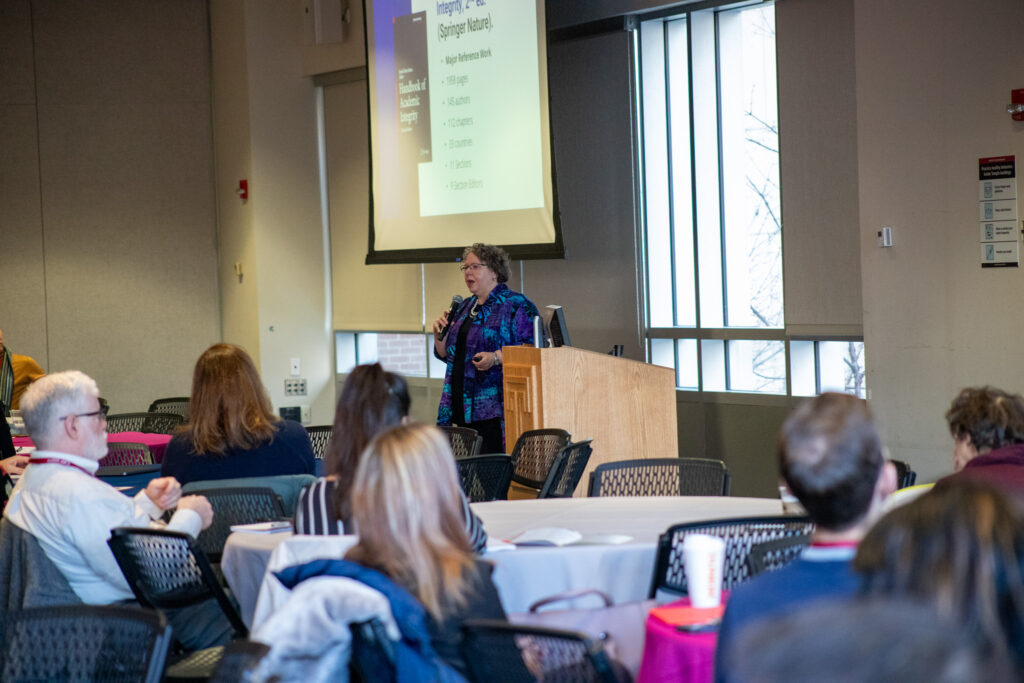
The CAT was honored to have Dr. Sarah Elaine Eaton, Associate Professor at the Werklund School of Education at the University of Calgary, Canada, who also holds a concurrent appointment as an Honorary Associate Professor at Deakin University in Australia. Her day one keynote was titled, Academic Integrity in a Postplagiarism World: The Impact of Generative Artificial Intelligence on Teaching, Learning, and Assessment.
Dr. Eaton began by defining a post-plagiarism world as an era in human society in which advanced technologies are a normal part of life, including how we teach, learn, and interact daily. After introducing us to the breadth of areas beyond student academic integrity that concern generative AI integrity in higher education, (e.g., publication ethics, research and integrity ethics, instruction ethics, and institutional ethics), she urged us not to approach student academic integrity from a “crime and punishment/I will catch you if you try to cheat” mindset. Rather, she suggested faculty and administrators adopt a more humanist mindset, as cheating is often a symptom of other problems, be it a lack of understanding or trying to handle multiple life responsibilities.
Dr. Eaton then presented some likely realities of a post-plagiarism world, suggesting that some hybrid of human-AI technologies will be the norm, including wearable and implantable AI. Dr. Eaton reminded us that wearable AI is already here as is implantable AI (a cochlear implant), and thus we need to be preemptive rather than speculative in our thinking so that we are not caught off guard as we were with AI/ChatGPT. She stressed that we have an imperative as faculty to ensure the ethical use of future AI to leave the education system better than when we found it, and lastly, that we must also remember that students cannot relinquish their responsibility for what they generate and submit!
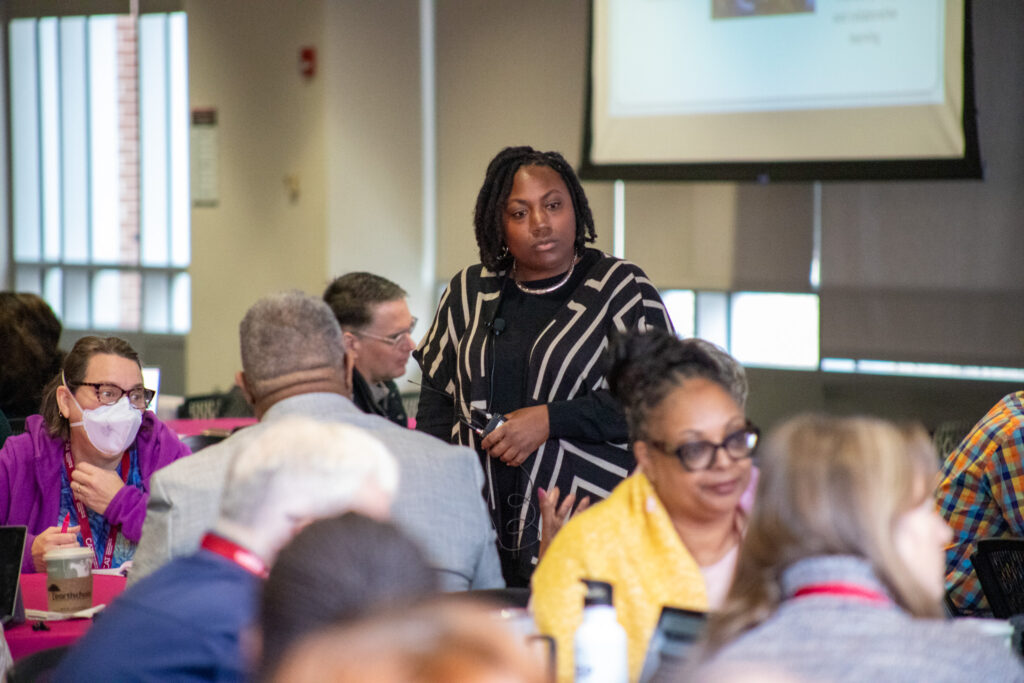
We were also delighted to have Dr. Sharla Berry, Associate Director of the Center for Evaluation and Educational Effectiveness at California State University, Long Beach. Her day two plenary session was titled, Teaching with Technology: Holistic Pedagogies in a Time of Change.
Dr. Berry helped us explore the sociocultural implications of our evolving digital learning landscape by posing some thought-provoking questions we need to reflect on regarding the development of AI and its use in education:
- While AI increases our ability to gather information, how are we ensuring that students have the ability to synthesize and use that information to benefit their learning? Is getting the right answer considered learning?
- Are we acknowledging and looking out for historical information from limited perspectives that result in biased output?
- Are we helping students to give better prompts that enable more balanced perspectives?
- What are the environmental impacts of AI? Dr. Berry shared a finding of U. of Massachusetts researchers cited in an MIT report titled Reducing the carbon footprint of artificial intelligence: “The amount of power required for training and searching a certain neural network architecture involves the emissions of roughly 626,000 pounds of carbon dioxide. That’s equivalent to nearly five times the lifetime emissions of the average U.S. car, including its manufacturing.”
- What are the social impacts of AI? Dr. Berry asked us to consider a variety of impacts, such as the substandard hourly wages paid to AI content moderators, the potential for AI to increase loneliness and social isolation, and its potential to enhance social interactions and connections with others.
In sum, Dr. Berry’s primary message was that while there are benefits of AI to humanity and society, there are also costs which need to be considered and addressed as we take a more holistic approach to assessing AI and its impacts
Building on the Keynote and Plenary Address
In addition to keynote and plenary speakers, the conference featured interactive workshops, breakout sessions, lightning talks, and poster sessions–all designed to generate discussion and share ideas for best teaching practices (with and without generative AI).
New this year was our AI Playground where participants tried out these generative AI programs:
- Claude AI (Can be used like ChatGPT; We used it to summarize PDF’s)
- LitMaps (Research based, can explore connections between articles)
- Gamma (Slide creation)
- Stable Diffusion (Image creation)
- Adobe Firefly (Image creation)
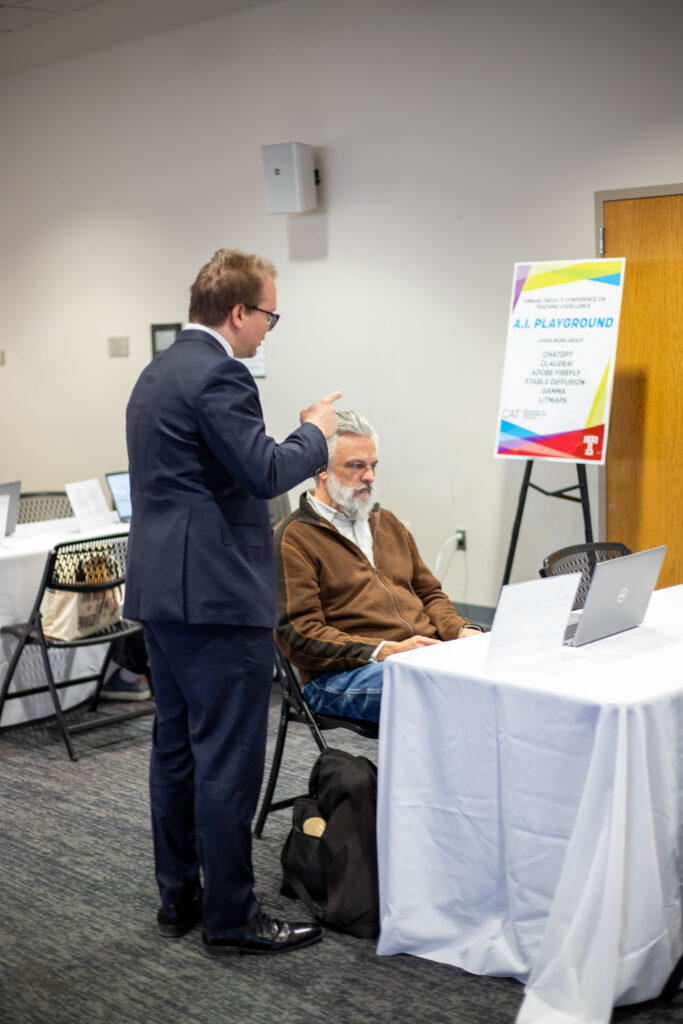
Let’s Continue the Conversation
Our 2024 Annual Faculty Conference generated many thought-provoking questions and teaching strategies, so let’s continue talking! Here are some ways you can keep the conversation going:
- Share what you’ve learned with your program/department faculty.
- Avail yourself of the robust AI resources on our website.
- Schedule a consultation with the CAT to work on incorporating what you have learned into your courses.
- Attend CAT workshops and consider joining one of our Faculty Learning Communities.
- Follow us on social media: Instagram, Facebook and Youtube.
- A full album of conference photos can be found on our Facebook!
On behalf of everyone at the CAT, we wish you a joyous new year and a fulfilling spring semester!
The Significance of Chinese Names and Their Pronunciation
By the staff of the Center for Chinese Language Instruction
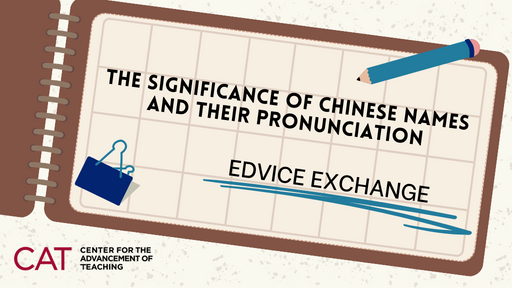
Everybody identifies with their name. Making the effort to pronounce a name correctly in class tells a student that you recognize them as a person they are and a welcome part of the class. Names are embedded in their cultures. Chinese names carry culturally rich meanings and a personal and shared history that reflect philosophical traditions and social customs. A person’s name tells the story of their parents’ ideals and hopes for them, aspirations that the name’s bearer often embraces throughout their life. So you can see, Chinese names are more than just labels.
Chinese names can be especially hard for non-Mandarin speakers. When talking about Chinese names, it is important to keep in mind that the basic unit in written Chinese consists of 3 parts: the character, the pronunciation and the meaning. All 3 parts come into play when naming a child. Below we will discuss Chinese naming culture in detail.
Cultural significance of a Chinese name
Chinese naming culture has deep historical roots. Traditional Chinese naming practices date back thousands of years and have been influenced by various philosophies and belief systems, most notably Confucianism, which emphasized the importance of family and ancestral heritage. Chinese names are typically structured with three elements: the family name (surname), the given name, and, in some cases, a generational name. The family name comes first, symbolizing the importance of family and heritage. This structure is in contrast to many Western naming conventions where the given name comes first. For example, a common name in America is Joe Smith. In China, they would be known as Smith John.
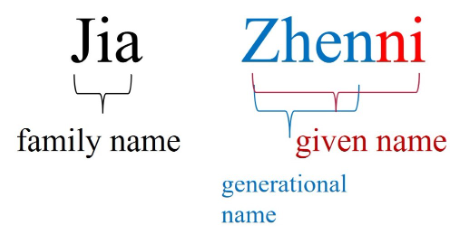
Family name: The family or surname appears first in Chinese culture and is of paramount importance. It represents not just an individual but an entire lineage. Surnames are shared by extended family members, reinforcing the sense of belonging and connection. There is a sense of pride and responsibility associated with carrying on the family name.
Given name: Given names appear after the family name and are carefully chosen. Families want to give children names that are phonetically and semantically meaningful. Names may be selected to reflect desirable qualities, aspirations, or the circumstances surrounding a child’s birth. Names chosen for boys often symbolize strength and power. Girls’ names often represent beauty and kindness. The process of naming is also believed to influence a person’s destiny.
Generational name: Generational names are built into a given name. They are used in maintaining continuity within the family and are passed down through generations, creating a sense of unity and tradition. It’s common for siblings and cousins related patrilineally from the same generation to share a generational name element. For example, Jia Zhenni and Jia Zhenhai are siblings. They have cousins named Jia Zhenhua, Jia Zhendong, Jia Zhenguo, and Jia Zhenxing. The ‘zhen’ is their generational name. When all of their names are spoken, you can hear the “zhen”, but they all use a different character and may have different meanings. In some families, the generational character is the same for all members of the generation. Another option is for all the males to share a character and all the females to share one.
Not all families use a generational name. Some generational names have been lost as time goes by. Some smaller families can’t trace their lineage back and do not have a family history of using them so choose to not use them going forward.
Choosing characters with good meaning: Chinese names are composed of characters, known as Hanzi. Each character can carry cultural, historical, and sometimes even spiritual significance. The choice of characters can convey deeper meanings and invoke connections to Chinese heritage. Chinese culture also has a rich folklore related to names. So, while some names are considered lucky, others are believed to bring bad fortune. These folk beliefs influence naming choices, especially for newborns. The character for ‘ugly’ is chou (丑) and another chou character (臭) means ‘bad smell’ making it unlikely that you would ever use any character pronounced chou in a name, even if it has a different meaning, because it is too close to ‘ugly’ and ‘stench’ in pronunciation.
Correctly pronouncing names is important. There are 4 tones in standard Chinese. Correct tones are crucial for conveying the intended meaning. If the pronunciation of a tone is wrong, a different word from the one intended is said. A common example of how the 4 tones distinguish words from one another uses syllables that share the consonant-vowel sequence ma but differ in tone. Mā in the first tone means ‘mom’. Má in the second tone means ‘trouble’. Mǎ in the third tone means ‘horse’. Mà in the fourth tone means ‘to scold’.
A Chinese name is always a Chinese word that has a tone as part of its correct pronunciation. Let’s look at an example of mispronouncing a tone in a name. In the name Wang Wèn (王问), the second syllable is in the fourth tone and has a meaning of a smart and inquisitive individual, this being a very good trait in Chinese culture. If pronounced Wang Wén (王蚊) with the second syllable in the second tone, it could mean mosquito which has bad associations.
One could also mispronounce a name and change its meaning. An example of this is the phrase Zhang Laoshi (张老师) which means Teacher Zhang. If the name Zhang is mispronounced as zang (脏), the resulting phrase Zang Laoshi could mean “dirty teacher,” something one would not want to call somebody, especially their teacher or professor.
What Can A Faculty Member Do To Learn Students’ Names?
Because of the meanings and histories names can hold, we should make every effort to learn how to pronounce them correctly. Chinese names can be especially hard for non-Mandarin speakers. Below are a few steps and suggestions faculty members can take to learn students’ names:
-
- Review your class roster before you get to the first class and make a note of any names for which you are unsure of the pronunciation.
-
- At the first class, when going over the roster for the first time, you can say, “It’s important to me that I learn how to pronounce everyone’s names correctly, so I will ask again if I need more help. Thanks for your patience as I try to learn your names.”
-
- Ask students to tell you the correct way to pronounce their names and make notes on your roster of the pronunciation for future reference. Repeat the name after the student pronounces it. Ask “Is that right?” to determine if you need to make adjustments to your pronunciation. But try not to call a student out by spending too much time on pronouncing their name in front of the entire class. Students might find this embarrassing. If need be, catch them after class or before the next class. Some students might also insist you call them by their American name and that is okay too. Your initial effort will not go unnoticed.
-
- Check out this Chinese pinyin chart with audio included from Chinese.Yabla.com. There are a number of common Chinese names you will be able to find on the chart. This will not account for the correct tone a Chinese name should be pronounced in without hearing it from the student first, but it will help with certain sounds and show you the difference between the pronunciation of the 4 tones.
-
- For a non-classroom setting, say a business meeting, interview or social event, it is totally fine to ask someone again the correct way to pronounce and say their name. Even repeat it a few times until you get it right.
Pronouncing a person’s name correctly is a sign of respect and cultural understanding, so the effort you put into learning students’ names will help you build a more positive rapport with students and signal that you care about them as people.
For more help with Chinese names and things related to Chinese culture, please contact the Center for Chinese Language Instruction at Temple University, ccli@temple.edu.
The Center for Chinese Language Instruction supports Chinese language instruction within the Chinese major and introduces Chinese popular culture through social and cultural events in the Temple community.
My trip down the AI rabbit hole

In her end of the semester wrap-up, our fearless leader reflects on her intellectual adventures springing from the emergence of A.I. as a factor in teaching in learning.
For further help on the role of A.I. in your classroom, visit our Faculty Guide to A.I. or book an appointment for a one-on-one consultation.
Stephanie Laggini Fiore, Ph.D., is Associate Vice Provost and Senior Director of Temple’s Center for the Advancement of Teaching.